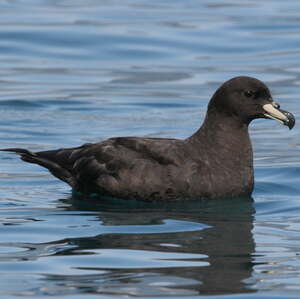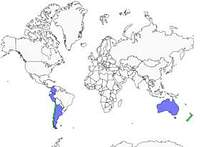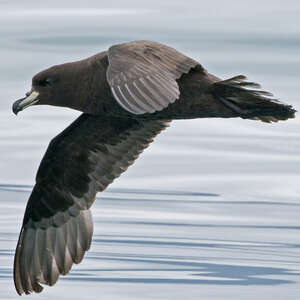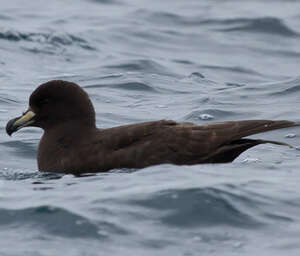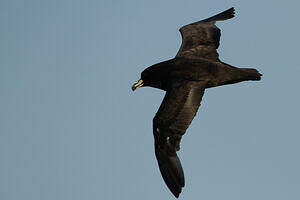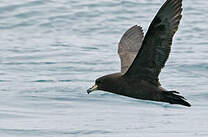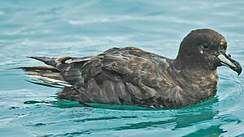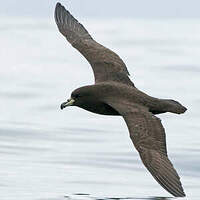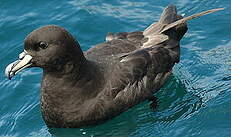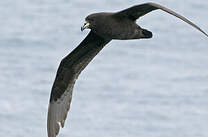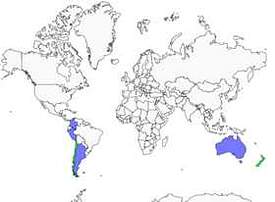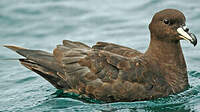Westland Petrel
Procellaria westlandica - Puffin du Westland
Identification
At sea, the Westland Petrel appears as a large, entirely dark, almost black puffin. On close inspection the colour is actually a very dark brown-chocolate. The legs are black and the beak is white-ivory with the tip more or less black. Black lines can also be seen between the various plates that make up the beak. From a moving boat it is far from easy to distinguish this species from the White-chinned Petrel (Procellaria aequinoctialis) which frequents the same waters. In comparison, this species is much larger and the extent of white under the beak is variable and rarely seen in the wild. However the beak is never blackish at the tip. There is also a risk of confusion with the Parkinson's Petrel (Procellaria parkinsoni) which is approximately the same size, but appears much lighter in flight. At this species too the beak has a black tip, but it is much less robust. This petrel usually frequents more northerly waters than the aforementioned two birds, however, individual birds are sometimes seen in the same places. At sea, identification is not always possible. Both sexes are similar and the juveniles are the same as the adults.
Subspecific information monotypic species
Foreign names
- Puffin du Westland,
- Pardela de Westland,
- pardela-preta-ocidental,
- Westland-Sturmvogel,
- westlandi viharmadár,
- Westlandstormvogel,
- Petrello del Westland,
- större sotpetrell,
- Westlandpetrell,
- víchrovník sadzový,
- buřňák novozélandský,
- Westlandskråpe,
- tasmanianmeriliitäjä,
- baldriga de Westland,
- burzyk ciemny,
- Уэстландский буревестник,
- ウエストランドクロミズナギドリ,
- 大黑风鹱,
- större sotpetrell,
- 西地風鸌,
Habitat
Endemic to New Zealand, the Westland Petrel is found at the foot of the hills, in the coastal forests of the northwest of the South Island. During the breeding season it frequents mostly the nearby waters of New Zealand. We have seen beautiful flocks off Kaikoura, on the east coast, less than an hour by boat from the port. From December to March, during the internuptial period, the Westland Petrels migrate to the centre and southeast of the Pacific Ocean, as far as Peru and Chile. Some head towards the waters off Eastern Australia.
Behaviour character trait
Flight
Flight is closely dependent on weather conditions, particularly the strength of the wind. If it is weak, the flight consists of long glides, wings outstretched and rigid, interrupted by rare wing beats. When the wind is strong, the species is seen to fly in large, bell-shaped circles in the air, always with a minimum of wing beats.
Dietfeeding habits
The Westland Petrel consumes a variety of small marine animals which it captures by diving from the surface and is able to chase underwater while swimming with its wings. It largely enjoys the waste left behind by fishing boats. Off the Kaikoura coast, we were able to witness them fiercely compete for the fish pieces. These leftovers seem to compose up to half of the species' diet.
Reproduction nesting
The breeding occurs during the austral winter. The female lays an egg in May in a burrow, under rocks or roots. Incubation and raising the chick is long and young birds don't leave the nest until December. If the immatures start to visit colonies around the age of 5 years, the Westland Petrels don't breed until they reach 12 years old.
Threats - protection
IUCN conservation status
concern
in the Wild
threatened
evaluated
The Westland Petrel is classified as 'vulnerable' by BirdLife International. The most recent estimates give a population of around 20,000 individuals, of which around 2,000 are breeding pairs. The main threat to this poorly productive species are introduced predators which consume eggs, chicks and even adults while they are incubating. Deer, also introduced and which have become hugely abundant in New Zealand, can cause burrows to collapse. Longline tuna fishing techniques are also believed to be a problem, as well as lights drawing birds ashore.
Sources of information
- IOC World Bird List (v15.1), Gill, F and D Donsker (Eds). 2025-12-07.
Other sources of interest
 Specification sheet created on
04/08/2023 by Georges Olioso
Specification sheet created on
04/08/2023 by Georges OliosoTranslation by AI Oiseaux.net
© 1996-2025 Oiseaux.net
- Accipitriformes
- Aegotheliformes
- Anseriformes
- Apodiformes
- Apterygiformes
- Bucerotiformes
- Caprimulgiformes
- Cariamiformes
- Casuariiformes
- Charadriiformes
- Ciconiiformes
- Coliiformes
- Columbiformes
- Coraciiformes
- Cuculiformes
- Eurypygiformes
- Falconiformes
- Galliformes
- Gaviiformes
- Gruiformes
- Leptosomiformes
- Mesitornithiformes
- Musophagiformes
- Nyctibiiformes
- Opisthocomiformes
- Otidiformes
- Passeriformes
- Pelecaniformes
- Phaethontiformes
- Phoenicopteriformes
- Piciformes
- Podargiformes
- Podicipediformes
- Procellariiformes
- Psittaciformes
- Pterocliformes
- Rheiformes
- Sphenisciformes
- Steatornithiformes
- Strigiformes
- Struthioniformes
- Suliformes
- Tinamiformes
- Trogoniformes

